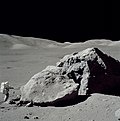Planetary geology
Planetary geology (or astrogeology or exogeology) focuses on the geology of any astronomical object like a planet, moon, asteroid, comet or meteorite.[1][2]
Planetary geologists study many topics. Some of these include the inner structure of the terrestrial planets, volcanism on planets, craters, fluvial and aeolian processes.
The planets will not solve all our problems. For example, we are running out of oil. That's vital for us today, and we may have to make it artificially, because we are running out of it. Oil is made by living things which (as far as we know) have no parallel elsewhere in the Solar System. However, there is a possibility of hydrocarbons on Titan, one of the moons of Saturn.
Planetary Geology Media
Planetary geologist and NASA astronaut Harrison "Jack" Schmitt collecting lunar samples during the Apollo 17 mission in early-December 1972
Surface of Mars in a false-color photograph by the Viking 2 lander, December 9, 1977
References
- ↑ "What is planetary geology?". James F. Bell III (Cornell University), Bruce A. Campbell (Smithsonian Institution), Mark S. Robinson (U.S. Geological Survey). Retrieved 6 October 2015.
- ↑ "GEOL212: Planetary Geology Fall 2015". University of Maryland Department of Geology. Archived from the original on 8 September 2021. Retrieved 6 October 2015.

